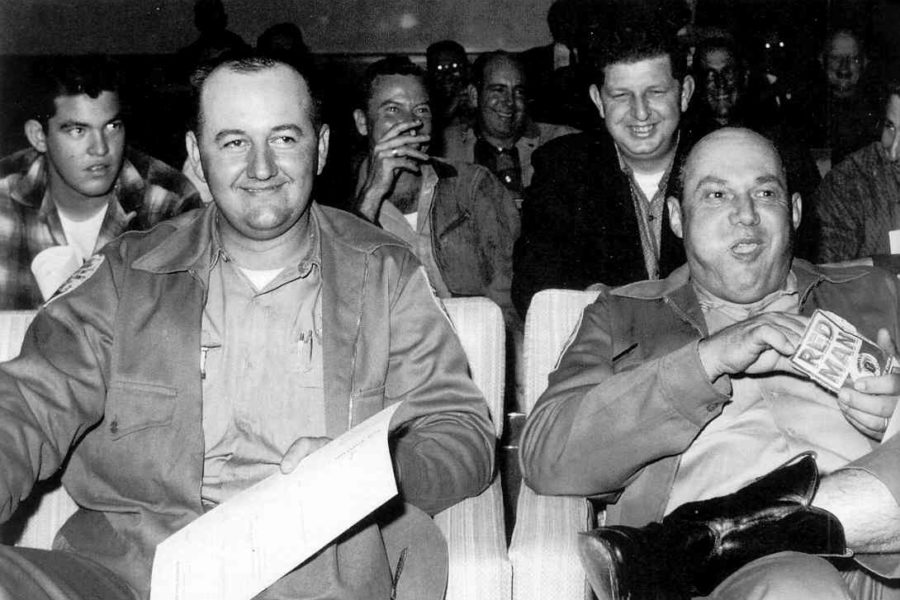In the 1940s, my parents lived in a small Georgia town where my father had his dental practice. He was friends with the chief of police and on good terms with many of the patrolmen. The police station was on the route between our house and my father’s office. When he walked home from work, it was not unusual for him to stop in and share pleasantries with whoever was on duty.
Dad loved to tell the story about one such visit during which one of the patrolmen expressed concern about his appearance.
“Doc,” he said, “you look worried. Somethin’ botherin’ you?”
Indeed there was. My dad told the officer that he had a patient who owed him a great deal of money and who, despite repeated demands, was refusing to pay his bill.
At this point, the inquiring officer leaned forward, looked my father square in the eye and, as he gestured toward two nearby lawmen, said softly, “You know, doc, me and the boys here belong to a special lodge. It’s one of those lodges where nobody can see your face.
“You want us to go give this fella’ a whuppin’?”
My father froze. In 1949 Georgia, a “lodge where nobody can see your face” was plainly and unequivocally a Klavern, a sub-unit of the Invisible Empire of the Ku Klux Klan. But, not wanting to give offense, he pretended to consider the criminal albeit well-intentioned offer.
“Gee, I don’t know,” he mused aloud. “Don’t pay Dr. Parry’s bill and get a licking from the Klan? I think that might scare off too many customers. But thanks anyhow!”
So it was that my father’s deadbeat patient got to keep his money and his dental work.
I couldn’t help but reflect on this bit of family lore while watching the television coverage of the recent Antifa beating in Portland, Oregon of conservative journalist Andrew Ngo. As with the old Ku Klux Klan, nobody could see the masked faces of the Antifa social justice thugs as they assaulted their victim in public and without apparent fear of interference by the police.
According to media reports, Portland’s progressive mayor has ordered the police to avoid confrontations with Antifa. Consequently, Antifa effectively has official sanction to roam the streets in disguise while brandishing weapons and threatening violence. For those of us who came of age in the Old South, this is a familiar and depressing scene.
But beyond the visuals, Ngo’s brutal beat down has many legal parallels to the 1964 murders of civil rights workers Michel Schwerner, James Chaney and Andrew Goodman. And the federal government’s investigation and prosecution of those murders provide a template for dealing with Ngo’s assailants and their local government enablers.
On June 21, 1964, Cecil Ray Price, the Deputy Sheriff of Neshoba County Mississippi, detained Schwerner, Chaney and Goodman in the county jail. After releasing them in the dark of night, he followed them in his patrol car. After they reached a remote area on the highway, Price pulled them over, placed them in his vehicle and delivered them to a group of 17 Klansmen who were waiting in the deep woods. This group included Neshoba County Sheriff Lawrence Rainey and a policeman from Philadelphia, Mississippi.
There in the middle of the night Schwerner, Chaney and Goodman were savagely beaten and shot to death.
Following a massive investigation by the FBI, all 18 defendants were arrested and charged with federal civil rights violations.
According to the federal indictments, the defendants had conspired to “punish” the victims without according them due process of law.
The indictments were based in part on 18 U.S.C. § 242 which imposes a fine of not more than $1,000 or imprisonment for not more than one year, or both, on “[w]hoever, under color of any law, statute, ordinance, regulation, or custom, willfully subjects any inhabitant of any State * * * to the deprivation of any rights, privileges, or immunities secured or protected by the Constitution or laws of the United States * * *.”
The First Count of the indictments alleged that all of the defendants conspired “to wilfully subject” Schwerner, Chaney and Goodman “to the deprivation of their right, privilege and immunity secured and protected by the Fourteenth Amendment to the Constitution of the United States not to be summarily punished without due process of law by persons acting under color of the laws of the State of Mississippi.”
On defendants’ motion to dismiss the indictments, the District Court denied the motion and sustained the First Count as to all defendants. As to the sheriff, deputy sheriff and patrolman, the court recognized that each was clearly alleged to have been acting “under color of law” as required by § 242. As to the private, non-police defendants, the District Court held that “(I)t is immaterial to the conspiracy that these private individuals were not acting under color of law” because the count charges that they were conspiring with persons who were so acting.
The District Court held that the indictment, in alleging the arrest, detention, release, interception and killing of Schwerner, Chaney and Goodman, adequately stated as the purpose of the conspiracy, a violation of § 242, and that this section could be violated by “wilfully subject(ing the victims) * * * to the deprivation of their right, privilege and immunity” under the Due Process Clause of the Fourteenth Amendment.
No appeal was taken by the defendants from the decision of the trial court with respect to the First Count.
The Second, Third and Fourth Counts of the indictments charged all of the defendants, not with conspiracy, but with substantive violations of § 242. Each of these counts charged that the defendants, acting “under color of the laws of the State of Mississippi,” “did wilfully assault, shoot and kill” Schwerner, Chaney and Goodman “for the purpose and with the intent” of punishing them and that the defendants “did thereby wilfully deprive” the victims “of their right to due process of law.
The District Court held these counts of the indictment valid as to the sheriff, deputy sheriff and patrolman. But it dismissed them as against the non-police defendants because the counts did not charge that the latter were “officers in fact, or de facto in anything allegedly done by them under color of law.”
But on appeal, the Supreme Court reinstated the Second, Third and Fourth Counts and held that private persons, jointly engaged with state officials in a prohibited action, are acting “under color” of law for purposes of the statute. In that regard, Justice Abe Fortas wrote:
“To act ‘under color’ of law does not require that the accused be an officer of the State. It is enough that he is a willful participant in joint activity with the State or its agents.
“In the present case, according to the indictment, the brutal joint adventure was made possible by state detention and calculated release of the prisoners by an officer of the State. This action, clearly attributable to the State, was part of the monstrous design described by the indictment. State officers participated in every phase of the alleged venture: the release from jail, the interception, assault and murder. It was a joint activity, from start to finish. Those who took advantage of participation by state officers in accomplishment of the foul purpose alleged must suffer the consequences of that participation. In effect, if the allegations are true, they were participants in official lawlessness, acting in willful concert with state officers and hence under color of law.”
An additional count charged each of the 18 defendants with a felony—a violation of 18 USC § 241. It charged that the defendants “conspired together * * * to injure, oppress, threaten and intimidate” Schwerner, Chaney and Goodman “in the free exercise and enjoyment of the right and privilege secured to them by the Fourteenth Amendment to the Constitution of the United States not to be deprived of life or liberty without due process of law by persons acting under color of the laws of Mississippi.” The indictment alleged that it was the purpose of the conspiracy that Deputy Sheriff Price would release Schwerner, Chaney and Goodman from custody in the Neshoba County jail at such time that Price and the other 17 defendants “could and would intercept” them “and threaten, assault, shoot and kill them.”
§ 241 provides for a fine of not more than $5,000, or imprisonment for not more than 10 years, or both, and reads as follows:
“If two or more persons conspire to injure, oppress, threaten, or intimidate any citizen in the free exercise or enjoyment of any right or privilege secured to him by the Constitution or laws of the United States, or because of his having so exercised the same; or
“If two or more persons go in disguise on the highway, or on the premises of another, with intent to prevent or hinder his free exercise or enjoyment of any right or privilege so secured—
They shall be fined not more than $5,000 or imprisoned not more than ten years, or both.”
The Supreme Court held that indictment of all of the defendants pursuant to this statute was proper. The case proceeded and all defendants were convicted.
So, how does any of this apply to Ngo’s public beating? First, it appears that the Antifa thugs conspired to “injure, oppress, threaten or intimidate” Ngo without due process of law because he had exercised his Constitutional right as a journalist to freely express an opinion. According to the media, Antifa targeted Ngo because they knew and disapproved of his opinions.
Moreover, it also appears that Antifa went “in disguise on the highway” with “intent to prevent or hinder” Ngo’s right to free expression and right not to be punished without due process of law.
Under either prong of the statute, Antifa appears to be subject to indictment.
Now, whether Antifa acted under color of law under § 242 or whether the mayor of Portland or other city officials can be held criminally responsible for those acts depends on the degree to which Antifa and the City of Portland combined, conspired, confederated or agreed to promote or permit Antifa’s campaign of terror and intimidation. To be sure, unlike the outrageous direct involvement of the Mississippi law officers in the murders of Schwerner, Chaney and Goodman, there has been no suggestion that Portland police actively joined in Ngo’s beating. But the question remains whether or not Portland’s hands-off-Antifa policy was part and parcel of a conspiracy to allow Antifa freedom to threaten, oppress, intimidate and deprive others of their civil rights.
In that regard, the bad news for Portland is that such a conspiracy can be proven without direct evidence of a formal agreement. In fact, most conspiracy cases involve an informal agreement which can be legally inferred from circumstantial evidence. On that basis, the facts and circumstances of how and why the City of Portland has allowed Antifa’s thugs to prowl its streets while wearing masks, brandishing weapons and threatening others warrant investigation by federal law enforcement. In particular, it should be determined whether there was a nexus between Portland’s hands-off-Antifa policy and the attack on Andy Ngo.
In addition to criminal liability, Portland may also be answerable in money damages if it can be proven that its official policy regarding Antifa was a substantial factor in bringing about Ngo’s injuries. Such potential civil liability should be considered by Ngo’s attorney who has promised to sue Antifa “into oblivion”. While Antifa’s social justice thugs may be without assets and, therefore, judgment proof, the City of Portland has comparably deep pockets. As such, Portland meets the prime legal criterion of a sue-worthy defendant.
Finally, while I have focused on the Ngo case, the FBI and Department of Justice should nevertheless seriously consider using the discussed legal concepts on a nationwide basis to bring about Antifa’s long overdue day of reckoning at the bar of justice.
Note: Pictured above are Neshoba County Deputy Sheriff Cecil Ray Price and Sheriff Lawrence A. Rainey after they had been arrested on state murder charges. Their apparent cheerfulness and confidence were well founded. They beat the state case. This resulted in the federal government bringing the above-discussed civil rights indictments.
George Parry is a former federal and state prosecutor. He is a regular contributor to the Philadelphia Inquirer and blogs at knowledgeisgood.net. He may be reached by email at kignet1@gmail.com.




Leave a Reply
Leave a reply.